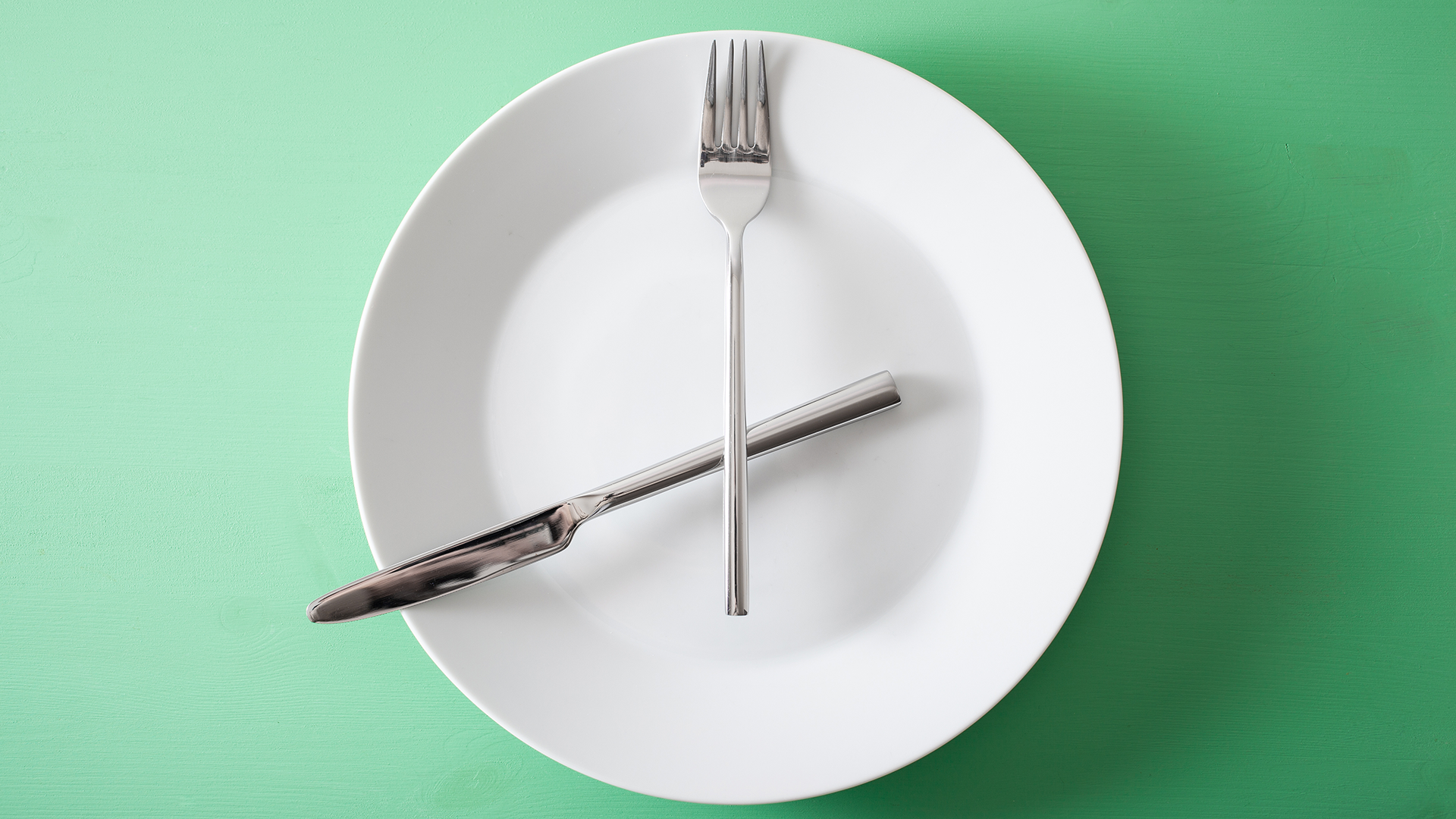Are you considering intermittent fasting as a new approach to your health and fitness journey? Well, here’s everything you need to know about this popular diet method.
Menopause can feel like a rollercoaster ride for many women, bringing a host of challenges from hot flashes to mood swings.
But maybe one of the most frustrating issues is the seemingly inevitable weight gain that creeps up around the midsection. If you're nodding your head in agreement, you're not alone.
You may have tried different approaches to conquering these menopause symptoms and managing your weight, but you’re at a standstill with it. Well, intermittent fasting may just be what you’re looking for.
Here, we'll dive into the world of intermittent fasting and explore how it could be beneficial for women navigating menopause.
We'll uncover the potential benefits, discuss important considerations, and give you the knowledge you need to decide if this approach might be right for you.
So, are you ready to learn about a potential new tool in your menopause management toolkit?
Fantastic! Let's get started.
What is intermittent fasting?
Intermittent fasting (IF) isn't a diet in the traditional sense—it's more about when you eat rather than what you eat.
At its core, intermittent fasting is a way of eating where you cycle between periods of eating and fasting, like having a set window of time each day when you eat and then taking a break from food.

It can be seen as a way to go beyond conventional eating patterns and tap into your body's natural rhythms.
Fasting has ancient roots and has been practiced for centuries across different cultures. But, the term ‘intermittent fasting’ gained modern popularity in the early 2000s when researchers and health enthusiasts began exploring its potential benefits more deeply.
Many people find IF to be a flexible and sustainable way to improve their health, lose weight, and boost energy. Stay tuned to learn more about IF's benefits.
What are the different methods of intermittent fasting?
Now, when navigating your intermittent fasting journey, it’s important for you to know all the methods on offer.
What works for one person may not work for another. That’s why we’ve made a list of the most common methods so you can see what will align with your lifestyle the best.
Here’s a rundown of some common intermittent fasting methods.
The 16/8 method (Leangains protocol)
This is one of the most popular and straightforward methods. You fast for 16 hours each day and have an eight-hour eating window.
For example, if you finish dinner by 8 PM, you wouldn’t eat again until noon the next day. This method is flexible—you can adjust the fasting window to suit your schedule.
The 5:2 diet
In the 5:2 method, you eat normally for five days of the week and then restrict your calorie intake to around 500 to 600 calories on the remaining two non-consecutive days. This method doesn’t require daily fasting, so it can be a bit more approachable for beginners.
The eat-stop-eat method
This method involves fasting for a full 24 hours once or twice a week. For instance, you might finish dinner at 7pm and not eat again until 7pm the next day.
While it can be challenging, many people find this method effective for breaking through weight-loss plateaus.

The alternate-day fasting
As the name suggests, you alternate between days of eating normally and days of fasting. Some variations allow for about 500 calories on fasting days, making it more manageable.
This method can be quite effective but may require more willpower, especially on fasting days.
The OMAD (one meal a day) method
As the name implies, you eat just one meal a day. This extreme form of intermittent fasting involves fasting for 23 hours and eating within a one-hour window. While effective for some, it can be challenging and isn’t suitable for everyone.
Note: Bear in mind that no single method is “best”—it’s all about finding what fits your life and goals. As with any diet change, it’s a good idea to listen to your body and consult with a healthcare professional, especially if you have underlying health conditions.
Understanding menopause and weight gain
Menopause comes with its challenges, but a common frustration is the symptom of weight gain.
As estrogen levels drop, our metabolism slows down, making it way easier to put on a few extra pounds, particularly around the belly.

Let’s delve deeper into how menopause can impact your weight…
Hormonal changes
When menopause hits, it can feel like your body’s hit the brakes, especially when it comes to weight.
The big culprit? A drop in estrogen. This hormone does a lot more than we realize, like keeping our metabolism revved up and helping us maintain muscle.
But as estrogen levels go down, so does our ability to burn calories efficiently, meaning even if you’re eating like you used to—your body might start storing more fat, especially around the belly.
On top of that, the loss of estrogen can cause a shift in body composition, with less muscle and more fat—which only slows things down further. It’s frustrating. But here’s the thing:
Once you understand what’s happening, you can go beyond just accepting it. By tweaking your habits and maybe trying out strategies like intermittent fasting, you can crush it and feel more in control.
Weight gain challenges
Menopause brings a lot of changes, and the weight gain that often comes with it can be super frustrating.
Suddenly, what used to work—whether it’s your go-to workout or your usual eating habits—just doesn’t cut it anymore. And those extra pounds seem to stick around no matter what.
Here are the main weight challenges you may face due to menopause…
- Slower metabolism: As estrogen levels drop, your metabolism slows down, making it easier to gain weight even if your eating habits haven’t changed.
- Increased abdominal fat: The hormonal shifts during menopause often lead to more fat being stored around the abdomen, which can be tough to lose.
- Loss of muscle mass: With age and hormonal changes, muscle mass decreases, which further slows down your metabolism and makes it harder to maintain your weight.
- Changes in fat distribution: Fat tends to shift from the hips and thighs to the abdomen during menopause.
- Reduced physical activity: Many women find it harder to stay active during menopause due to joint pain, fatigue, or other symptoms, contributing to weight gain.
- Increased insulin resistance: Hormonal changes can lead to insulin resistance, making it harder for your body to manage blood sugar levels and leading to increased fat storage.
We understand that it’s easy to feel down when your body isn’t responding the way it used to—but we want to encourage you to rise up and embrace the skin you’re in.

By embracing these changes and making adjustments, you will be empowered to take steps to manage your weight while radiating confidence at the same time.
Understanding your body’s new needs means you can take charge, find what works for you, and feel great in your skin again.
Read: 5 expert-recommended healthy diets for sustainable weight loss
Benefits of intermittent fasting for menopausal women
If you’re navigating menopause and you’ve been seeking a fresh way to feel more in control, intermittent fasting could just be the route for you.
From tackling stubborn weight gain to boosting your energy, intermittent fasting offers benefits that can help you shine brighter than ever.
Let’s further explain the health benefits intermittent fasting has to offer while going through menopause.
Weight management
Intermittent fasting can help kick your metabolism into gear. By creating eating windows and fasting periods, you give your body a chance to burn fat more effectively.
This can help manage weight gain, which is often a struggle during menopause due to hormonal changes.
Improved insulin sensitivity
As estrogen levels drop, insulin resistance can increase, making it harder to regulate blood sugar and leading to weight gain.
Intermittent fasting helps improve insulin sensitivity by giving your body regular breaks from eating, which can help stabilize blood sugar levels and reduce fat storage.
Reduced inflammation
Menopause can come with increased inflammation, leading to joint pain and fatigue.
Intermittent fasting can help lower inflammation markers in the body, easing these symptoms and helping you feel more comfortable.
Better sleep
Many women experience disrupted sleep during menopause. Intermittent fasting may promote better sleep patterns by stabilizing blood sugar levels and reducing symptoms that can interfere with restful sleep.

Balanced mood
Hormonal fluctuations can impact your mood and emotional well-being. Intermittent fasting might help regulate mood swings and improve emotional stability by balancing hormones and supporting overall wellbeing.
By incorporating intermittent fasting into your routine, you can tackle these common menopause challenges and feel more in control of your health and energy levels.
Intermittent fasting and menopause: What you need to know
No new journey is easy to start, and there will always be challenges. But when you’re equipped with what you need to navigate them, it heightens your chances of being successful.
So, if you’re thinking about giving intermittent fasting during menopause a try, here are some key things to keep in mind.
Nutrition
When you’re eating, make those meals count. Focus on nutrient-rich foods like fruits, veggies, lean proteins, and whole grains.

Menopause can increase your need for certain vitamins and minerals, so loading up on these goodies will help keep you feeling great and energized.
Bone health
With menopause, keeping your bones strong is super important. Make sure you’re getting enough calcium and vitamin D, which are crucial for bone health.
Think leafy greens, dairy products, and foods fortified with vitamin D. Your bones will thank you.
Hormone balance
Intermittent fasting can have a positive effect on hormone levels, potentially helping with some of those menopause symptoms.
It’s all about finding balance, and while fasting might help regulate things, everyone’s body is different, so results can vary.
Talk to a healthcare professional
Before diving into any new diet or fasting plan, chat with your doctor. They can give you the best advice based on your personal health needs, making sure intermittent fasting is a good fit for you.
Read: Low-intensity workouts: Essential tips, ideas & benefits
Getting started with intermittent fasting (the right way)
Choosing the right intermittent fasting diet method can be difficult, but we all have to start somewhere.
The powerful thing is…you can navigate this journey how you want to. If one method doesn’t work well, you can try another one.

That said, here are some tips on how to find an IF journey that fits your lifestyle…
Consider your schedule
Look at your daily routine and pick a method that meshes well with your life. If you’re not a morning person, the 16/8 method (fasting for 16 hours and eating within an eight-hour window) might be ideal because you can skip breakfast and eat lunch and dinner.
If you have a busy schedule and prefer more flexibility, the 5:2 method (eating normally for five days and cutting back on calories for two non-consecutive days) could work better.
Think about your goals and preferences
Think about what you’re aiming to achieve. If you're comfortable with longer fasting periods, eat-stop-eat (fasting for 24 hours once or twice a week) might be effective.
For those who prefer not to fast every day, alternate-day fasting (alternating between normal eating and fasting days) could be a good option.
Evaluate your eating habits
If you enjoy larger meals or multiple meals a day, time-restricted eating (eating all your meals within a specific time frame, like 10 or 12 hours) might be the way to go. It allows for flexibility while still giving your body a break from constant eating.
FYI: Before jumping in, especially if you have any health concerns or conditions, check in with your healthcare provider.
They can help ensure that the method you choose is safe and tailored to your needs. Once you get the go-ahead, start with a method that feels manageable and see how your body responds. You can always adjust as you go.
Read: The top benefits of sustainable weight loss
Additional tips for success
Sometimes, incorporating a new diet into your lifestyle can be tricky, but this is where we come in.
Let’s take a look at some tips that can make this intermittent fasting during the menopause journey as smooth as it can be for you.
- Start slow and begin with a method you feel you can manage.
- Drink plenty of water throughout your fasting periods, as it helps with hunger and keeps your energy levels up.

- Plan balanced meals which are filled with nutrient-dense foods, including a mix of protein, healthy fats, and fiber to keep you satisfied and support overall health.
- Consider taking supplements to meet any nutrition gaps, like calcium and vitamin D to support bone health, and magnesium for overall wellbeing. Always check with your doctor before starting any new supplements.
- Incorporate regular physical activity into your routine. Exercise can complement intermittent fasting by boosting metabolic health, supporting weight management, and improving overall health.
- Join a community or find a fasting buddy who can provide the motivation and support you need to keep hitting your goals with confidence.
- Be patient and consistent. It can take a while to see results with sustainable weight loss methods like intermittent fasting—it’s not a quick solution. The more consistent and patient you are, the more likely you are to see results.
- It’s essential to listen to your body on this journey. Understanding your own needs, recognizing when something isn’t working, and making adjustments based on how you feel can make all the difference.
Final thoughts…
Congratulations. You've made it to the end of our intermittent fasting journey for women and its potential benefits for managing menopause.
We've learned that intermittent fasting is a powerful tool that could help alleviate some of the most challenging menopause symptoms, from stubborn weight gain to mood swings. By tapping into your body's natural rhythms, intermittent fasting may help you regain a sense of balance and vitality.
Of course, it's important to approach intermittent fasting mindfully and with the guidance of your healthcare provider.
If it sounds like something you want to try and your doctor gives you the go-ahead, we hope you feel empowered to start your journey.
With the right plan and a supportive community, you can conquer the obstacles of menopause and feel your absolute best.
We’re wishing you all the best on your journey.
Conquer your fitness and wellness goals with PhenQ
While IF can help you shed pounds and offer some health benefits, it’s not the only way to reach your goals.
Successful weight loss is all about patience, consistency, and finding what works best for your body. With the right tools and information, you can choose a path that leads to sustainable, long-term results.
At PhenQ, we’re here to help you reach your goals the right way. With our products and expert advice, you’ll have everything you need to succeed.
Visit our official blog for tips, support, and knowledge to keep you on track. We’re with you every step of the way.



